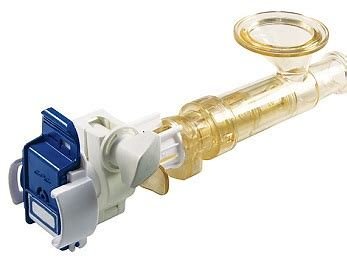CPC Launches New MicroCNX Connectors, a First for Small-Volume Biopharma Processing
02 September 2021 | Thursday | News

CPC (Colder Products Company), part of Dover (NYSE: DOV) and maker of a broad range of single-use connectors, today announced the launch of a new ultra-compact sterile connector providing biopharmaceutical manufacturers a much-needed alternative to tube welding for their small-volume closed aseptic processes. MicroCNX™ Series Connectors are the industry's first aseptic connectors designed to provide a simple, efficient method of connecting tubing in small-format assemblies.
"MicroCNX connectors are a critically important option for a range of bioprocessing, cell therapy and gene therapy workflows," said Troy Ostreng, Senior Product Manager for CPC's biopharmaceutical business. "Until now, cumbersome tube welding has been the only way to make sterile closed connections of very small-bore tubing. The MicroCNX connector represents a huge innovation for the industry."
MicroCNX connectors are designed specifically for small-volume processes involving widely used 1/16" (1.6mm), 3/32" (2.4mm) and 1/8" (3.2mm) tubing. These include sampling, seed train expansion and early cell culture processes involving shaker flasks and rocker tables.
"The MicroCNX series was designed to help manufacturers improve efficiencies and reduce time and total cost in creating closed systems that deliver reliable, reproducible results," said Ostreng.
Testing indicates that making a sterile connection with the new connector is up to four times faster than an operator using a tube welder.1 Meaning, in the time required to create one weld, up to four MicroCNX connections could be completed. Multiply those numbers over the course of a year, and the operational efficiencies are clear.
The easy, three-step process for using MicroCNX connectors requires minimal training. Users simply "Pinch-Click-Pull": 1) pinch to remove the protective cover; 2) click together the connector halves; and, 3) pull out the protective membranes so flow can start. In comparison, tube welding involves a dozen or more steps, with operator challenges including maneuvering the tube welder into position, dealing with equipment maintenance, and requiring precise technique to create a successful weld. With MicroCNX solutions, there is no risk of faulty welds, welder breakdowns, or production delays due to weld equipment downtime.
Use of aseptic connectors eliminates the need to purchase, calibrate, validate and maintain tube welders that can cost more than $15,000 each. Manufacturers often need multiple welders, which take up valuable space in a cleanroom.
"It's expensive and time-consuming to validate new space," Ostreng noted. "MicroCNX connectors can help biopharmaceutical and cell and gene therapy manufacturers make the most of their existing cleanroom space."
In order to ensure a clear flow path, tube welding requires operators to manually restore the tubing's shape after being crimped by a weld. In contrast, MicroCNX connectors help deliver a consistent flow path with every connection. Because MicroCNX connectors can be incorporated into pre-made tubing assemblies, operators know where to make connections—there's no guesswork on their part, which supports current good manufacturing practices (cGMP). The size, weight and geometry of the new connector also fit well with the trend toward compact automated equipment for use in processes like cell expansion.
For more information about MicroCNX Series Connectors and how tube welding and aseptic connectors compare, visit endoftheweld.com.
Most Read
- Top 25 Biotech & Biopharma Leaders in Sustainable Innovation, 2025
- China’s Biopharma Dealmaking Surges in H1 2025, Driven by Record Licensing and Oncology Focus
- Chikungunya in China: How a “Forgotten” Arbovirus Found the Perfect Storm
- How Innovation Gaps in Biopharma Raise New Safety Concerns
- Smart Implants and the Future of Musculoskeletal Injury Treatment
- How Ethical Gaps in Psychiatry Could Undermine Biopharma Progress
- The Evolving Landscape of Women’s Health Innovation in the Asia-Pacific
- Using NLP-Driven Decision Support in Emergency Health Assistance
- Taiwan Steps Into the Global Spotlight With a New Cancer Therapy
- The Role of Unique Device Identification (UDI) in Tracing Medical Device Safety
- The Importance of a Patient’s Mental Health During Clinical Trials
Bio Jobs
- The State of Biotech and Life Science Jobs in Asia Pacific – 2025
- Avantor’s New CEO Ligner Aims to Unlock Global Potential and Deliver Shareholder Value
- AstraZeneca Commits $50 Billion to U.S. Expansion by 2030 in Biggest-Ever Global Investment
- Thermo Fisher, SAMRC, and South Africa’s Department of Science and Innovation Launch CATIR to Nurture Next-Gen Scientists
- Cube Biotech Appoints Former Sartorius CEO Dr. Joachim Kreuzburg to Board of Directors
- FDA’s AI Transition Marks a Turning Point in Drug Review: Industry Faces Pressure to Adapt Amid 20% Workforce Cut
- WuXi XDC Completes Mechanical Build of Singapore Bioconjugate Manufacturing Hub
News
Editor Picks











